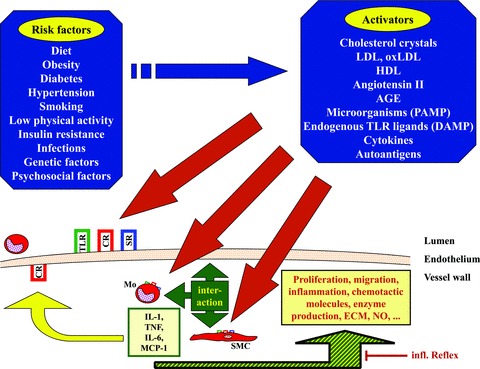Fig 1.

Contribution of cytokines and innate molecules to atherosclerosis by initiation of inflammation and cell interaction related to atherosclerosis (schematic overview). Blue arrow and blue fields: The different classical risk factors may be represented by one or more of the listed activators. Red arrows: These activators trigger cells in the lumen or the vessel wall via innate and cytokine receptors (TLR, SR, CR) expressed on the various cells (on SMCs and Mo the receptor symbols are downscaled). The activators may initiate atherogenesis by either causing endothelial activation/dysfunction, by activation of invading leucocytes, causing enhanced inflammation and/or by reaching the vessel wall tissue and activating an inflammatory response in the local vessel wall cells. Triple-headed green arrow and box: Cytokines will be produced and their production results in cytokine-mediated interaction of the cells inside the vessel wall, followed by (green-yellow hatched arrow) enhanced expression of cytokines, chemokines, enzymes, proliferation, cell death and other functions. Some relevant cytokines are mentioned in the pale yellow box framed in green. Dark yellow arrow: Cytokines and chemokines, produced in the vessel wall upon interaction of monocytes and vessel wall cells, also may cause expression of adhesion molecules and recruitment of more leucocytes. Slim red Tee-arrow: Regulation of inflammation in the vessel wall may be influenced by the ‘inflammatory reflex’ proposed earlier [136]. AGE: advanced glycation end product; CR: cytokine receptor; DAMP: damage-associated molecular pattern; ECM: extracellular matrix; HDL: high-density lipoprotein; LDL: low-density lipoprotein; Mo: monocyte; NO: nitric oxide; oxLDL: oxidized LDL; PAMP: pathogen-associated molecular pattern; SMC: vascular smooth muscle cell; SR: scavenger receptor; TLR: toll-like receptor.
